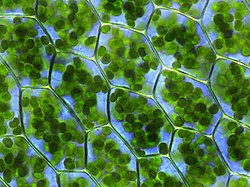Transpiration and cooling

Evapotranspiration is the combined processes moving water from the earth's surface into the atmosphere. Transpiration is the movement of water through a plant and out of its leaves and other aerial parts into the atmosphere. This movement is driven by solar energy. [4] In the tallest trees, such as Sequoia sempervirens, the water rises well over 100 metres from root-tip to canopy leaves. Such trees also exploit evaporation to keep the surface cool. Water vapour from evapotranspiration mixed with air moves upwards to the point of saturation and then, helped by the emissions of cloud condensation nuclei, forms clouds. Each gram molecule (mole) of condensing water will bring about a marked 1200-fold plus reduction in volume.The simultaneous release of latent heat will drive air from below to fill the partial vacuum. The energy required for the surrounding air to move in is readily calculated from the small (one-fifteenth of latent heat) reduction in temperature.[ citation needed ]
A small amount of that water transpired is used for growth and metabolism. Photosynthesis takes place in the cells of plants and other organisms such as algae, that contain chlorophyll. This process uses the radiant energy from the sun to split water molecules into hydrogen and oxygen that when combined with the carbon sourced from carbon dioxide, produces sugars. Photosynthesis is therefore the basis of almost all food production and produces oxygen as a byproduct. [ citation needed ]

Leaves have many functions. In addition to receiving water from the roots and creating the raw materials for photosynthesis, they also have a large internal surface area to enable the exchange of gases. Their stomata control the flow of water vapour out of the leaf and air into the leaf. In many plants, this is achieved in a structure thin enough to be semi-translucent, to enable some light to pass through to neighbouring leaves. The water that becomes raw material for sugar production, also cools the leaf and supports its structure through the pressure of turgidity. [5] In 2022, attempts to mass-produce artificial leaves to replicate this process and create hydrogen were still in the development stage. [6] All organic matter, living and dead, originated as sugars. Part of the process of creating those sugars was splitting the water molecule into its component parts. Vegetation has a huge influence on climate, enacted through photosynthesis and transpiration.
Botanists have calculated that there are about 600 square inches [3,871 cm2] of surface inside a leaf for every cubic inch [16.38 cm3] of its bulk and that a large elm tree has in all some 15 million leaves within an area, if spread out whole, of nearly 10 acres [4.05 ha] or, if unfolded into the sum total of air-breathing light-absorbing surfaces of all the internal chloroplasts something like 25 square miles [64.75 square kilometres]. [5]
Plants cool when they transpire. Evaporating water and transmitting it through leaf stomata requires a lot of energy. Fred Pearce states that "a single tree transpiring a hundred litres of water a day has a cooling power equivalent to two household air-conditioning units" [7] (p. 29). An individual tree can transpire hundreds of litres of water per day. Transpiring 100 litres is equivalent to a cooling power of 70 kWh. [3] [2] Jan Pokorny posits that a tree with a crown of 5 metres diameter covers an area of about 20m2. Of the 150 kWh falling on the crown, 1% is used for photosynthesis, 10% reflected as light energy, 5 to 10% as sensible heat with the remaining 79 to 84% entering the process of transpiration. [3]
If a larger tree has a sufficient water supply, it can evaporate more than 100 L of water a day. In order to evaporate 100 L of water, approximately 70 kWh (250 MJ) of solar energy is needed. This energy is hidden in water vapor as latent heat and is released again during the process of condensation to liquid water. [3]
Extrapolated to a hectare, the cooling power of a closed canopy is 35,000 kWh a day.

Cities with constructed surfaces and devegetation are typically warmer than adjacent countryside. This phenomenon is known as urban heat islands. For example Tokyo's average September temperature has increased by almost 2 °C. over 100 years. This differential would increase in the summer months. Significant increases for cities in the tropics such as Dhaka are projected, accelerated by urban growth and intensification. [8] The city of Melbourne "plans to plant 3000 trees in Melbourne every year to increase the resilience of the urban forest and to cool our city by 4°C." [9] Increasing tree cover and evapotranspiration provides a localised mitigation solution.
On a larger scale, The Mau Forest complex in Western Kenya was deforested from 5,200 km2 in 1986 to 3,400 km2 in 2009. Satellite images revealed temperature increases with deforested areas being 20 °C hotter or more.[ citation needed ]
There were about six trillion trees on the planet, but human activity has destroyed roughly half. [7] Increasing terrestrial biomass will cool the planet. Of the latent heat that escapes at recondensation at cloud level half departs the atmosphere into space, as the photons escape in a part of the spectrum that does not get reabsorbed by greenhouse gases.
Using satellite imagery, the impact of regeneration processes restoring vegetation in arid areas is visible from space and can tracked over time. Vegetation restoration is clearly visible in images of the Penbamoto project in Tanzania.Seeing African Restoration from Space: Planet and Justdiggit... The data associated with these images reveal a temperature reduction in the topsoil up to 0.75 °C. [10] This temperature reduction was achieved in four years. We can anticipate a larger reduction as the vegetation cover increases.



